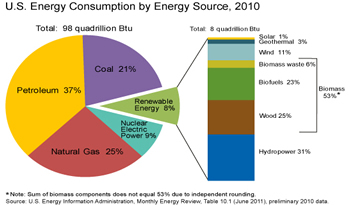What Is Energy?
Energy sources are of two types: nonrenewable and renewable. Energy sources are considered nonrenewable if they cannot be replenished (made again) in a short period of time. On the other hand, renewable energy sources such as solar and wind can be replenished naturally.
1. Nonrenewable
About 92% of the energy consumed in the United States comes from non-renewable energy sources, which include uranium ore and the fossil fuels — coal, natural gas, and petroleum.
Nonrenewable energy sources come out of the ground as liquids, gases, and solids. Crude oil (petroleum) is the only commercial nonrenewable fuel that is naturally in liquid form. Natural gas and propane are normally gases, and coal is a solid.
Fossil Fuels Are Nonrenewable, but Not All Nonrenewable Energy Sources Are Fossil Fuels
Coal, petroleum, natural gas, and propane are all considered fossil fuels because they were formed from the buried remains of plants and animals that lived millions of years ago.
Uranium ore, a solid, is mined and converted to a fuel used at nuclear power plants. Uranium is not a fossil fuel, but is a nonrenewable fuel.
2. Renewable
Renewable energy sources including biomass, hydropower, geothermal, wind, and solar provide 8% of the energy used in the United States. Most renewable energy goes to producing electricity.
What Is Renewable Energy?
Renewable energy sources can be replenished.
What Role Does Renewable Energy Play in the United States?
The use of renewable energy is not new. More than 150 years ago, wood, which is one form of biomass, supplied up to 90% of our energy needs. As the use of coal, petroleum, and natural gas expanded, the United States became less reliant on wood as an energy source. Today, we are looking again at renewable sources to find new ways to use them to help meet our energy needs.
In 2010, consumption of renewable sources in the United States totaled about 8 quadrillion Btu — 1 quadrillion is the number 1 followed by 15 zeros — or about 8% of all energy used nationally. About 10% of U.S. electricity was generated from renewable sources.
Over half of renewable energy goes to producing electricity. The next largest use of renewable energy is biomass (wood and waste) for the production of heat and steam for industrial purposes and for space heating, mostly in homes. Biomass also includes biofuels, such as ethanol and biodiesel, used for transportation.
Renewable energy plays an important role in the supply of energy. When renewable energy sources are used, the demand for fossil fuels is reduced. Unlike fossil fuels, non-biomass renewable sources of energy (hydropower, geothermal, wind, and solar) do not directly emit greenhouse gases.
Why Don’t We Use More Renewable Energy?
In the past, renewable energy has generally been more expensive to produce and use than fossil fuels. Renewable resources are often located in remote areas, and it is expensive to build power lines to the cities where the electricity they produce is needed. The use of renewable sources is also limited by the fact that they are not always available — cloudy days reduce solar power; calm days reduce wind power; and droughts reduce the water available for hydropower.
The production and use of renewable fuels has grown more quickly in recent years as a result of higher prices for oil and natural gas, and a number of State and Federal Government incentives, including the Energy Policy Acts of 2002 and 2005. The use of renewable fuels is expected to continue to grow over the next 30 years, although EIA projects that we will still rely on non-renewable fuels to meet most of our energy needs.
Source: U.S. Energy Information Administration. (www.eia.gov)




